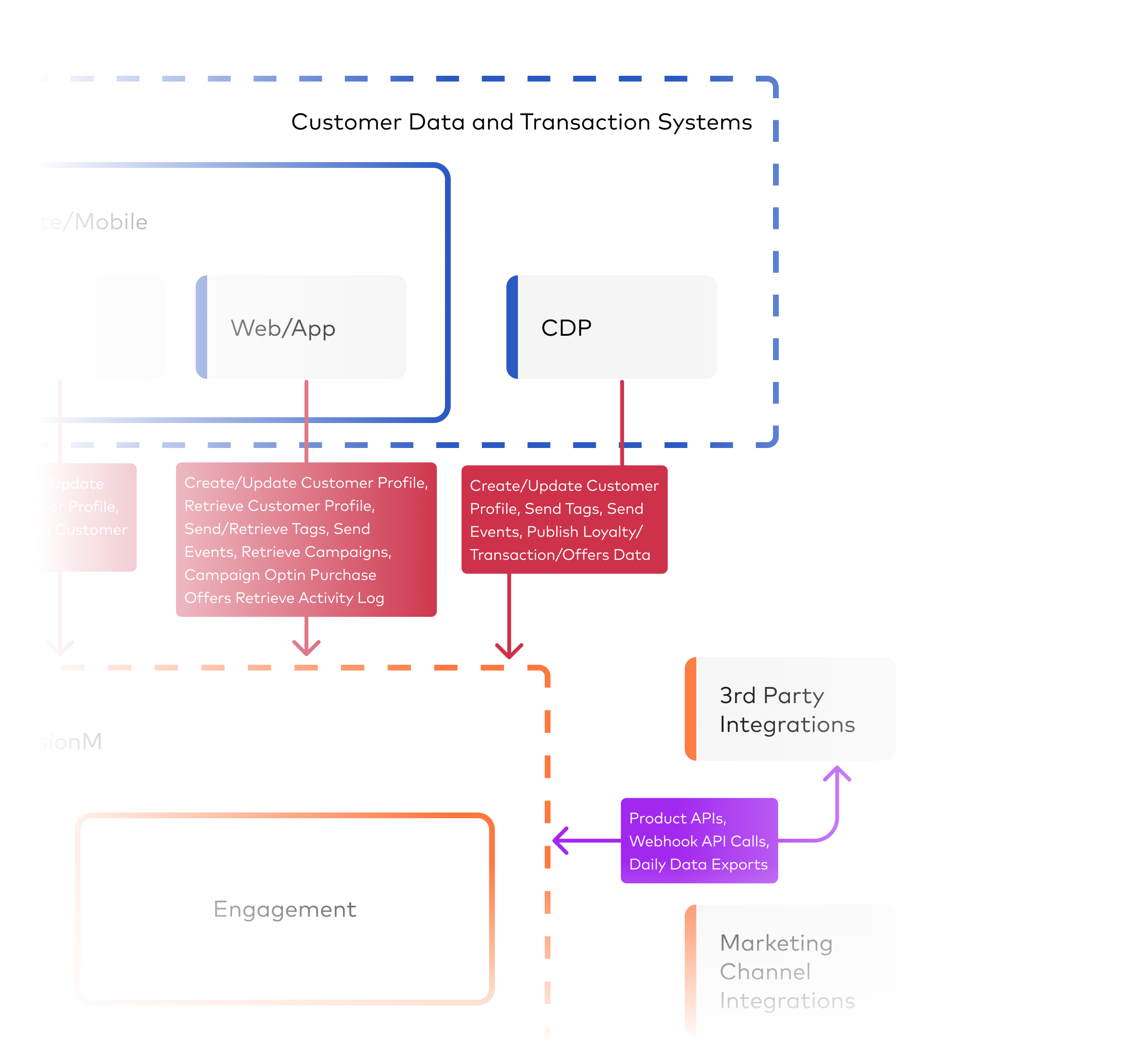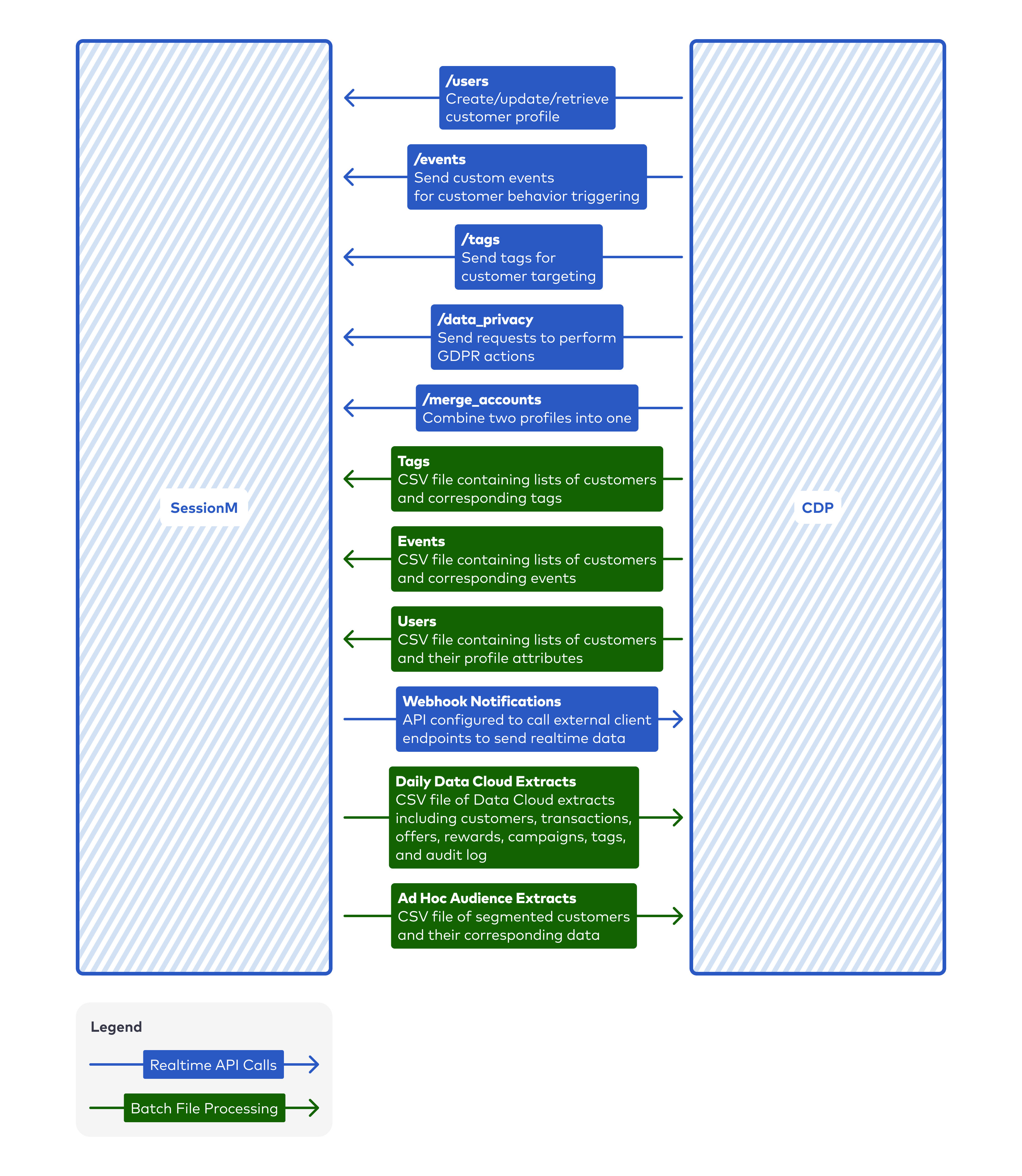Customer Data Platform Integration
A typical Customer Data Platform (CDP) tracks who the customers are and what actions they have taken during their interactions with any web sites or applications. These actions usually pertain to customer profile creations and updates as well as external targeting. Data from customer profiles, which includes aggregates of both declared and inferred attributes is particularly important. This data can then undergo analytics and segmentation that can be leveraged to create targeted customer groups.
Generally, once data is residing in the CDP, it can flow two ways into SessionM: Via platform APIs or in batch within CSV files.
The APIs can support a real-time data flow from a variety of external data feeds, including updated metrics and activity details. These APIs provide endpoints that ensure data can be refreshed and updated dynamically, so changes are captured immediately.
Alternatively, if the data is more static and not in need of constant updates, it may make more sense to upload data in batch at a more conservative cadence. For this kind of a flow intermittent updates are adequate, especially when the payloads are not populated with custom data.
Every integration is different and the capabilities of a given CDP can vary a great deal. So, identifying the right approach - which can include a mix of both the API-driven and the batch - is essential. It really does depend on the client's loyalty programs and the other players in their overall merchant ecosystem.
Also worth noting for this kind of integration is the existence of functionality that allows data to flow the opposite direction, from SessionM to a CDP. Extracts from the SessionM data lake or of audiences comprising segmented customers can be extracted into CSV files and then delivered to a CDP. Data lake extracts can include customer, transaction, offer, reward, campaign and tag data. One final option is the provision of webhooks that allow SessionM to notify external client endpoints that they can send data to whatever destinations have been configured for their integrations.
The data collected and maintained in a CDP is valuable to SessionM, which has an inherent interest in receiving customer data and the non-transactional events from triggers that deliver a steady flow of new loyalty data. These kinds of data are particularly useful when implementing tags for audience segmentation and promotional campaigns.
Ultimately, CDP software allows organizations to collect customer data from multiple sources and build a complete view of the data in a single customer profile based on the SessionM data model. The integration under discussion in this topic is highlighted in the image below.

A CDP integration manages the profile and activity data associated with customer as well as output derived from any analytics or segmentation.
Once a CDP is integrated with SessionM, you can use platform APIs to make real-time calls for the communications and transactions required for a variety of use cases. The following core tasks are critical when implementing CDP use cases for customers:
- Creating, retrieving, updating or merging customer profiles
- Sending events to trigger behaviors
- Sending tags for customer targeting
- Performing data privacy actions
Using Customer Data
A CDP integration works extensively with SessionM data, providing advanced identity resolution services that ensure the platform contains no duplicate data. This data can describe purchase activities, loyal tiers, loyalty point balances, and the offers/rewards stored in customer wallets. In fact, a CDP is built to take data from several sources, thereby reducing a reliance on complex data integrations and custom ETL jobs that extract, transform and load data. The CDP ensures it will be easier to convert customer data so it can reside within the Lesson data model.
CDP data can animate the life cycle typical of customers represented in the SessionM Platform. That life cycle flow utilizes CDP data in the following sequence as it pertains to customers:
-
Acquire - Uses data to generate audience segments of non-loyalty customers.
-
Activate - Uses data to build "welcome" journey for customers.
-
Engage - Uses data analytics to measure and inform changes for promotional campaigns and communications that increase customer engagement and spend.
-
Re-activate - Use data analytics to identify lapsed or churning customers that can be targeted with customized journeys.
Using Non-transactional Data
Another important type of data tracked by a CDP flows from triggers for non-transactional events. Note that from SessionM considers all events to be non-transactional; any transactional events should be handled by the Transactions API. Non-transactional data derives from a variety of web traffic, including events transpiring on social media. It arrives from sources and partners intent on maintaining the data in a CDP. Common sources for this generated data include:
-
Abandoned web site sessions and checkout carts
-
Messaging and email service provider platforms
-
Third-party connectors
-
Completed profile attributes
-
Two-factor authentication
-
Survey responses
-
Campaign opt-ins
Data Unused by SessionM
Some data, with little relevance to SessionM, can remain in the CDP unshared. SessionM doesn't support anonymous data, housekeeping data, and profile histories. There are exceptions, however; for example, a client running a promotional campaign may want SessionM to use SessionM APIs to send CDP data to a 3rd party messaging platform. But if the client is defining their own targeting, there is no reason for us to duplicate that effort, especially given the nature of security risks when opening up unnecessary access points. Such duplication can lead to out-of-date data.
Key Integration Endpoints
While this topic does focus on the standard aspects of a CDP integration, each implementation can contain specific transaction data points specific to business, or vertical, needs.
The diagram below depicts the key endpoints enabling a standard CDP integration:
You can access technical details for endpoints featured in this graphic using the links below:
-
Endpoints that specify /users in their path
-
Endpoints that specify /events in their path
-
Endpoints that specify /tags in their path
-
Endpoints that specify /privacy in their path
-
Endpoints that specify /merge_accounts in their path
Most of the emphasis on CDP data is on how the CDP can integrate with SessionM and provide data via SessionM API endpoints. However, as you can see in the image above, that's not the case for all data. This integration path is characterized by three other dynamics:
-
CSV or JSON files containing tag, event, or user data being sent in batch jobs to SessionM from the CDP. For more information, see documentation on SM Sync toolset.
-
Data lake and ad hoc audience extracts flowing in the opposite directions - from SessionM to a CDP via daily data feeds. In this context, SessionM is updating the CDP with the most current versions of loyalty data. For these extracts, APIs are irrelevant. These data feeds provide data files to the CDP in batch jobs that reflect transactions, offers, points and tier data from the SessionM data cloud. Please reach out to your SessionM account team for schema definition details.
-
Webhook notifications that call external endpoints to send real-time data. SessionM offers very flexible outbound webhooks that can integrate with any system as long as it has published API specifications.
Integration Best Practices
As you move forward with your integration, bear in mind several best practices that can help ensure a successful SessionM implementation.
-
SessionM APIs are designed for capturing customer profile data and triggering events in real time.
-
Event feeds, however, are the preferred approach if the CDP is sending SessionM all of the events on a one-time, daily basis. In this case, data files are preferred, as it ensures the platform doesn’t get inundated with multiple updates.
-
When data can only be sent in bulk on some defined basis, then the primary types of data served by APIs - user, event, and tag data - all have batch file routes for their ingestion into the SessionM platform. For more information discuss with your SessionM customer success team.